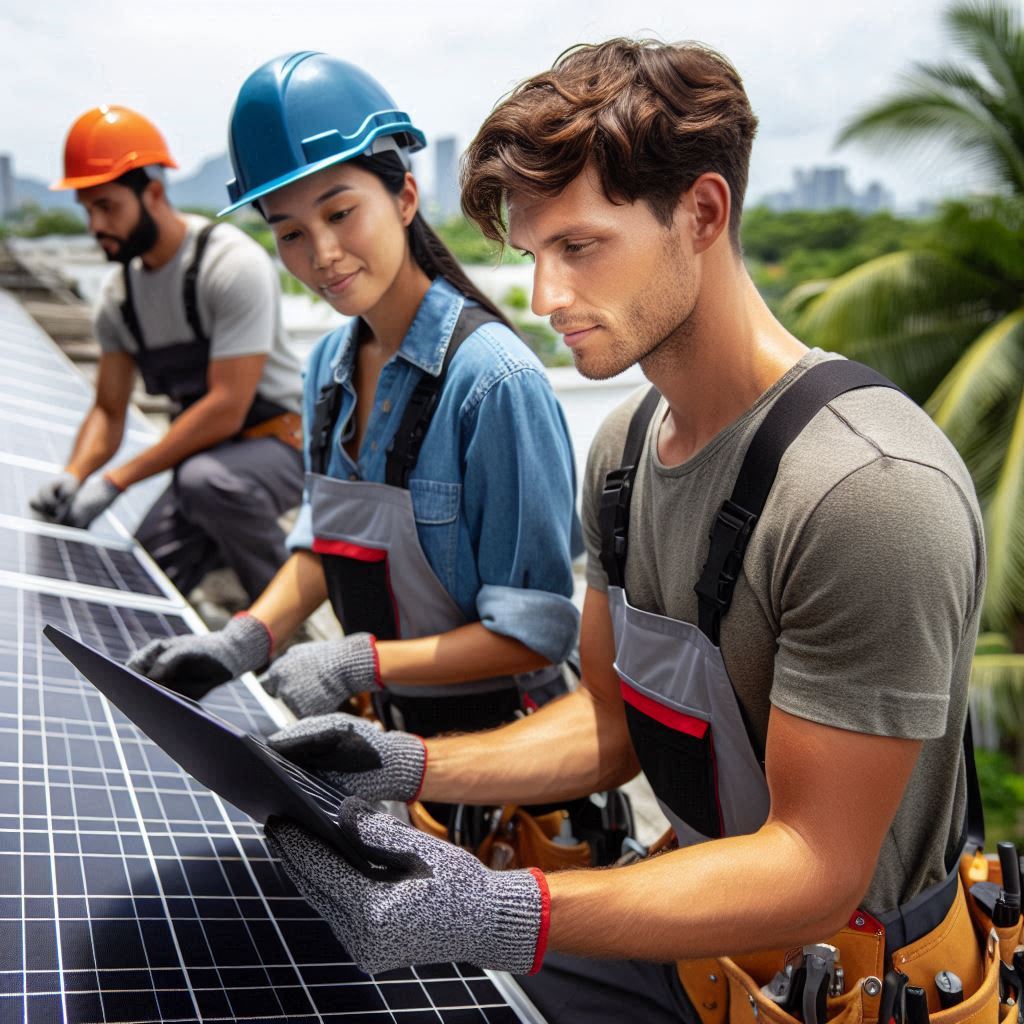Introduction
Solar PV installations have seen a remarkable surge in popularity as more individuals and businesses recognize their benefits.
Solar energy is celebrated for its ability to provide a clean, renewable power source that helps reduce greenhouse gas emissions.
By converting sunlight into electricity, solar PV systems play a significant role in lowering carbon footprints and mitigating climate change.
The increasing adoption of solar technology reflects a growing commitment to environmental sustainability.
As more people and organizations seek to minimize their reliance on fossil fuels, solar energy becomes a key component in achieving a greener future.
This shift not only supports global efforts to combat climate change but also promotes energy independence and security.
The expansion of solar energy use highlights the importance of skilled solar PV installers.
These professionals are crucial in ensuring that solar systems are installed correctly and operate efficiently.
As the demand for solar installations rises, understanding the common challenges faced by these installers is essential.
Addressing these challenges effectively helps improve installation quality and contributes to the overall success of solar energy projects.
Lack of Proper Training and Certification
The Importance of Proper Training for Solar PV Installers
Proper training is crucial for solar PV installers to ensure safe and efficient installations.
Training provides installers with the skills needed to handle complex systems and avoid common pitfalls.
Well-trained installers understand how to optimize panel placement and wiring to maximize energy production.
They also learn essential safety protocols to protect themselves and others on-site.
Comprehensive training covers both technical skills and safety procedures, helping installers address potential issues before they arise.
By investing in training, companies ensure their staff can handle various installation challenges effectively.
Challenges Faced by Installers Without Comprehensive Training
Installers lacking proper training face numerous challenges that can impact the quality and safety of installations.
Without adequate training, installers may struggle with correctly assessing installation sites, leading to inefficient energy production.
Incomplete understanding of electrical systems can result in improper wiring, increasing the risk of electrical faults.
Untrained installers might also neglect critical safety measures, exposing themselves and others to hazards.
Poor installation practices can lead to frequent maintenance issues and reduced system performance.
These challenges can affect customer satisfaction and the overall reputation of the installation company.
Suggestions for Addressing This Issue, Such as Investing in Training Programs
To address the challenges faced by installers without comprehensive training, investing in training programs is essential.
Companies should implement regular training sessions that cover the latest technologies and best practices.
Offering hands-on training allows installers to practice their skills in real-world scenarios.
Certification programs can validate installers’ expertise and enhance their credibility.
Providing ongoing education keeps installers updated on industry standards and safety regulations.
Investing in training programs not only improves installation quality but also boosts worker confidence and job satisfaction.
Companies that prioritize training can achieve higher performance standards and greater customer satisfaction.
Enhanced skills and knowledge lead to more efficient installations and safer work environments.
Complex Permitting and Licensing Processes
The Intricate Process of Obtaining Permits and Licenses for Solar Installations
Obtaining permits and licenses for solar installations involves a complex and often lengthy process.
Installers must navigate local, state, and federal regulations, each with its requirements.
The process typically starts with submitting detailed plans to local authorities.
These plans include system specifications, site layouts, and compliance with building codes.
Installers must also obtain electrical permits, which often require inspections and approvals.
Additional steps may include obtaining utility approvals and adhering to zoning regulations.
This intricate process ensures that installations meet safety and performance standards but can be time-consuming and confusing.
Common Roadblocks Faced by Installers During This Process
Several common roadblocks can complicate the permitting and licensing process for solar PV installations.
One major challenge is navigating differing regulations across various jurisdictions.
Local governments may have unique requirements, which can delay approvals.
Installers may also face difficulties in obtaining timely inspections and approvals from utility companies.
Bureaucratic red tape and slow processing times can further hinder progress.
Inconsistent or unclear guidelines can lead to misunderstandings and additional paperwork.
These obstacles can increase project timelines and costs, impacting overall efficiency and customer satisfaction.
Recommendations for Streamlining the Permitting and Licensing Procedures
To streamline permitting and licensing procedures, consider the following recommendations.
First, familiarize yourself with local regulations and requirements early in the planning process.
This proactive approach helps avoid surprises and delays.
Establish clear communication channels with local authorities and utility companies to expedite approvals.
Utilize online permitting systems where available, as they can speed up submission and tracking processes.
Standardizing documentation and procedures across jurisdictions can also reduce complexity.
Additionally, engaging with industry associations and local solar organizations can provide valuable insights and support.
These steps can help overcome common challenges and make the permitting process more efficient.
Basically, obtaining permits and licenses for solar installations is a complex process involving multiple regulations and approvals.
Installers often face roadblocks such as varying local requirements, bureaucratic delays, and unclear guidelines.
Streamlining these procedures involves understanding regulations, maintaining clear communication, using online systems, and standardizing processes.
By implementing these recommendations, installers can navigate the permitting and licensing process more effectively, reducing delays and improving project efficiency.
Limited Access to Quality Equipment and Materials
Challenges of sourcing high-quality solar panels, inverters, and mounting hardware
One of the major challenges faced by solar PV installers is the limited access to quality equipment and materials.
Sourcing high-quality solar panels, inverters, and mounting hardware can be a difficult task, especially in regions where the solar industry is still developing.
Installers often struggle to find reliable suppliers who can provide them with the necessary components to build efficient and durable solar PV systems.
Impact of subpar equipment on the performance and longevity of solar PV systems
Using subpar equipment can have a significant impact on the performance and longevity of solar PV systems.
Low-quality solar panels, inverters, and mounting hardware may not be able to withstand harsh environmental conditions or provide the level of efficiency required for optimal energy production.
This can result in system failures, reduced energy generation, and increased maintenance costs for installers and their customers.
Strategies for identifying reputable suppliers and ensuring product quality
To address the challenge of limited access to quality equipment and materials, solar PV installers can implement strategies for identifying reputable suppliers and ensuring product quality.
One approach is to conduct thorough research and due diligence on potential suppliers to verify their reputation and track record.
Installers can also look for certifications and quality standards that demonstrate the reliability and performance of the products offered by suppliers.
Additionally, installers can establish relationships with trusted manufacturers and distributors who have a proven track record of delivering high-quality equipment.
By building strong partnerships with reputable suppliers, installers can access a reliable source of quality products and materials for their solar PV projects.
This can help ensure the long-term performance and durability of solar PV systems, ultimately benefiting both installers and their customers.
Read: Continuing Education for Radiologic Technologists
Safety Concerns and Compliance Regulations
The Safety Risks Associated with Solar Installations
Solar PV installations, while beneficial, come with inherent safety risks that installers must manage.
Electrical hazards are among the most significant risks.
Handling live wires and electrical components can lead to severe injuries if proper precautions are not taken.
Installers should always use insulated tools and wear appropriate personal protective equipment (PPE) to mitigate these risks.
Falls are another major concern during solar panel installations.
Working at heights on rooftops or elevated structures increases the likelihood of falls.
Installers should use proper fall protection equipment, such as harnesses and safety nets, to prevent accidents.
Ensuring secure ladders and scaffolding is essential for safe access and stability.
Heat-related illnesses can occur, especially during summer installations.
Solar PV work often involves exposure to intense sunlight and high temperatures.
Installers should stay hydrated, take regular breaks, and wear protective clothing to prevent heat stress and dehydration.
Importance of Adhering to Safety Regulations and Standards
Adhering to safety regulations and standards is crucial for preventing accidents and ensuring the well-being of installation teams.
Regulations set by organizations like OSHA (Occupational Safety and Health Administration) provide guidelines to minimize risks.
Compliance with these standards ensures that all safety measures are implemented correctly and consistently.
Following industry standards also enhances the quality and reliability of solar installations.
Proper safety practices reduce the likelihood of equipment malfunctions or failures that could pose risks.
Adherence to regulations fosters a safe working environment and contributes to the overall success of the project.
Training is a key component of safety compliance.
Regular training sessions keep installation teams updated on the latest safety protocols and practices.
Comprehensive training programs help installers recognize potential hazards and implement effective safety measures.
Tips for Promoting a Culture of Safety Within the Installation Team
Promoting a culture of safety within the installation team is essential for reducing risks and enhancing overall safety.
Start by establishing clear safety protocols and expectations.
Ensure that all team members understand their roles and responsibilities regarding safety procedures.
Encourage open communication about safety concerns.
Create an environment where team members feel comfortable reporting hazards or incidents without fear of reprisal.
Regular safety meetings and discussions can help address issues and reinforce the importance of safety.
Provide ongoing safety training and resources.
Equip your team with the latest information on safety practices, equipment, and regulations.
Encourage continuous learning and improvement to maintain a high standard of safety.
Recognize and reward safe behavior.
Acknowledge team members who consistently follow safety protocols and demonstrate a strong commitment to safety.
Positive reinforcement can motivate others to adhere to safety practices.
Therefore, managing safety risks is crucial in solar PV installations.
Adhering to regulations and fostering a culture of safety within the team helps prevent accidents and ensures successful installations.
By prioritizing safety, installers can protect themselves and contribute to the overall success of solar energy projects.
Read: Common Mistakes in Quality Control Inspections

Customer Education and Communication
Benefits and Costs of Solar Energy to Potential Customers
Solar PV installers often face challenges in explaining the benefits and costs of solar energy to potential customers.
Many customers may not fully understand how solar energy works or its financial advantages.
The initial investment can seem high, even though long-term savings can be substantial.
Installers need to clearly communicate the return on investment, potential savings on utility bills, and available incentives.
It is essential to break down complex technical terms into easily understandable language.
Providing clear, visual comparisons of costs and savings can help customers grasp the value of solar energy.
Addressing customer concerns and questions promptly can also improve their understanding and confidence in solar technology.
Importance of Clear and Effective Communication with Clients Throughout the Installation Process
Clear and effective communication is crucial throughout the solar installation process.
Installers must keep clients informed about each stage of the project.
This includes timelines, potential delays, and any changes to the initial plan.
Regular updates help manage client expectations and build trust.
Effective communication also involves setting realistic expectations regarding installation outcomes and system performance.
Addressing concerns and providing answers to questions promptly ensures clients feel valued and understood.
Detailed explanations of the installation process can also help clients prepare their property and reduce any potential disruptions.
By maintaining open lines of communication, installers can foster positive relationships and enhance customer satisfaction.
Suggestions for Improving Customer Education and Managing Expectations
Improving customer education and managing expectations can greatly enhance the installation experience.
Start by providing comprehensive educational materials that explain solar technology, benefits, and costs.
Use brochures, videos, and online resources to make information accessible and engaging.
Offer free consultations to discuss customer needs and tailor solutions to their specific situation.
During these consultations, provide clear, detailed estimates and explain the factors affecting costs and savings.
Set realistic timelines and explain potential delays due to weather or supply issues.
Encourage customers to ask questions and provide thorough answers.
Post-installation, offer follow-up sessions to review system performance and address any concerns.
Providing ongoing support and maintenance options can further reassure customers and enhance their overall satisfaction with the solar energy system.
Read: Best Online Courses for CAD Technician Training
Transform Your Career Today
Unlock a personalized career strategy that drives real results. Get tailored advice and a roadmap designed just for you.
Start NowVariable Weather Conditions and Site Limitations
Impact of weather fluctuations and site constraints on the efficiency of solar PV systems
One of the common challenges faced by solar PV installers is the impact of variable weather conditions and site limitations on the efficiency of solar PV systems.
Weather fluctuations such as cloud cover, rain, snow, and even extreme temperatures can significantly affect the performance of solar panels, leading to reduced energy production.
Moreover, site constraints such as shading from nearby buildings or trees, limited space for installation, and suboptimal orientation can further exacerbate the challenges faced by solar PV installers.
These factors can hinder the ability of solar PV systems to generate sufficient electricity, ultimately affecting the overall profitability and sustainability of the installation.
Strategies for Mitigating the Effects of Adverse Weather and Optimizing System Performance
To address these challenges, solar PV installers can implement various strategies to mitigate the effects of adverse weather conditions and optimize the performance of solar PV systems.
One such strategy is the use of advanced forecasting tools to predict weather patterns and adjust system settings accordingly.
Additionally, installers can incorporate technologies such as micro-inverters, power optimizers.
Energy storage systems to maximize energy production and minimize the impact of shading or other site limitations.
By using these technologies, installers can improve the overall reliability and efficiency of solar PV systems, even in challenging environments.
Case Studies Highlighting Successful Installations in Challenging Environments
Several case studies demonstrate successful solar PV installations in challenging environments, showcasing the effectiveness of innovative solutions and best practices.
For example, a project in a region with frequent cloud cover utilized tracking systems to maximize sunlight exposure, resulting in increased energy production.
Another case study focused on an installation with limited rooftop space, where the use of bifacial solar panels and optimized system design allowed for higher energy yields despite spatial constraints.
These examples highlight the importance of adaptability and creativity in overcoming challenges related to variable weather conditions and site limitations.
In essence, while solar PV installers face significant challenges due to variable weather conditions and site limitations.
They can overcome these obstacles by implementing strategic solutions and leveraging emerging technologies.
By adapting to changing circumstances and embracing innovative approaches, solar PV installers can optimize system performance and achieve success even in the most challenging environments.
Read: CAD Technician Job Market: Trends and Insights
Competition and Pricing Pressures
The Competitive Landscape of the Solar Industry
The solar industry faces intense competition, driven by rapid technological advancements and growing market demand.
Many companies vie for market share, leading to a highly competitive environment.
New entrants often challenge established players, increasing competition for both residential and commercial projects.
This competitive landscape pushes companies to innovate and improve their offerings to stand out.
Additionally, fluctuations in government incentives and subsidies can impact market dynamics, further intensifying competition.
Understanding these dynamics is crucial for solar PV installers to navigate the competitive market effectively.
Challenges of Pricing Pressure and Undercutting by Competitors
Pricing pressure is a significant challenge in the solar industry.
As competition increases, some companies resort to aggressive pricing strategies to attract customers.
Undercutting by competitors can drive down prices and reduce profit margins for all players in the market.
This pressure often forces companies to lower their prices to remain competitive, sometimes at the expense of service quality.
Installers must carefully balance offering competitive prices while maintaining profitability and service standards.
Navigating this challenge requires a strategic approach to pricing and cost management to sustain business operations effectively.
Tips for Differentiating Services, Adding Value, and Setting Competitive Pricing
To thrive in a competitive market, solar PV installers should focus on differentiating their services.
Offering unique value propositions, such as advanced technology or superior customer service, can set a company apart.
Investing in high-quality equipment and providing comprehensive warranties can enhance the perceived value of your services.
Building strong customer relationships and offering personalized solutions also helps differentiate your business.
When setting competitive pricing, consider factors like the cost of materials, labor, and overheads.
Use market research to understand pricing trends and adjust your prices accordingly.
Providing flexible financing options can also attract customers and make your services more appealing.
Regularly reviewing and updating your pricing strategy helps ensure that it remains competitive while sustaining profitability.
In summary, the competitive landscape of the solar industry presents challenges such as pricing pressure and competitor undercutting.
Installers must differentiate their services by adding unique value and maintaining high-quality standards.
Setting competitive pricing requires balancing cost management with market trends and customer expectations.
By implementing these strategies, solar PV installers can navigate the competitive market, attract customers, and achieve long-term success.
Maintenance and Warranty Issues
Importance of regular maintenance for ensuring the longevity and efficiency of solar PV systems
Solar PV systems, like any other technology, require regular maintenance to ensure they perform efficiently and last for their expected lifespan.
Regular maintenance helps prevent issues before they escalate, saving both time and money in the long run.
By conducting routine inspections and cleaning solar panels, installers can identify and address any potential problems early, minimizing downtime and maximizing system performance.
Common problems faced by installers when addressing maintenance requests
Some of the common challenges faced by solar PV installers when addressing maintenance requests include scheduling conflicts, access issues, and communication barriers.
Installers often have to coordinate maintenance visits with homeowners, sometimes needing to work around busy schedules or access restrictions.
Communication with customers regarding maintenance needs and scheduling can be challenging, especially if there are language barriers or misunderstandings about the scope of work.
Additionally, obtaining necessary replacement parts or equipment can sometimes be a logistical challenge, delaying repairs and maintenance activities.
Best practices for offering warranties and post-installation support to customers
When it comes to offering warranties and post-installation support, clear communication and transparency are key.
Installers should provide customers with detailed warranty information upfront, outlining what is covered and for how long.
Offering extended warranties or service contracts can provide customers with peace of mind and ensure they have access to ongoing support for their solar PV systems.
Establishing a process for handling warranty claims efficiently and effectively can help build trust and customer satisfaction.
Regular communication with customers about maintenance recommendations and available support services can also help prevent issues before they arise.
Conclusion
Solar PV installers encounter several significant challenges that impact their work.
Key challenges include technical difficulties, weather-related delays, and regulatory hurdles.
Technical issues often involve complex installations and system integration, requiring installers to solve intricate problems.
Weather conditions, such as extreme heat or storms, can cause delays and disrupt project timelines.
Additionally, navigating regulatory requirements can be time-consuming and complex, adding to the overall project burden.
Addressing these challenges is essential for promoting the growth and efficiency of the solar industry.
By effectively overcoming these barriers, installers can improve the quality and speed of installations, thereby increasing the adoption of solar energy.
Tackling these issues not only benefits individual projects but also supports the broader expansion of solar technology and its integration into mainstream energy solutions.
We call for increased collaboration and innovation to address these obstacles.
Industry professionals must work together to develop effective solutions and streamline installation processes.
Embracing new technologies and sharing best practices will help overcome these challenges and drive progress in solar energy.
By joining forces and fostering innovation, we can build a more resilient and dynamic solar industry, ultimately contributing to a sustainable and clean energy future.
[E-Books for Sale]
The Big Book of 500 High-Paying Jobs in America: Unlock Your Earning Potential
$19.99 • 500 High-Paying Jobs • 330 pages
Explore 500 high-paying jobs in America and learn how to boost your career, earn more, and achieve success!
See All 500 High-Paying Jobs of this E-Book
1001 Professions Without a Degree: High-Paying American Jobs You Can Start Now
$19.99 • 1001 Professions Without a Degree • 174 pages
Discover 1001 high-paying jobs without a degree! Unlock career tips, skills, and success strategies for just $19.99!




